|
FEA Thermal Analysis by Jared
Heated Lift Table Platform
Below are some pictures I've generated showing the results of a thermal analysis for a product I engineered. The product is a lift table with the top platform heated to 120F. The customers application was a 7,000 lb wax die. They wanted to pre-heat the die before using it in thier manufacturing process. This pre-heating increases thier productivity, as well as decreases heat fatigue in the die, prolonging the life of the tool that was very expensive to build. The goal was to have the platform at 120 degrees F with a heat variation of less than +/- 5 degrees F. That way the metal platform would not suck out a massive number of BTU's when the die was taken out of the molding machine and put on the table. Also when the die came from storage, and was relatively cold, putting it on the platform and pre-heating it before installing it in the mold machine, would allow the mold machine to produce more parts, increasing it's yield. The maximum temperature we can go with is 120F. Above that temperature will increase the chances of getting burns, which is not acceptable. |
|
The pictures to the left show an attempt at using strip heaters, a low cost readably available heater. The ones to the left were off the shelf items that produced 12 watts per in2. As you can see these produced too much heat in too small of an area to get the desired +/- 5F. This indicated the die would initially transfer a great many BTU's to the platform until the platform was heated up, increasing the thermal fatigue in the die. Also the platform would not transfer BTU's into the die at a reasonable rate, causing a very long pre-heat cycle time. So another approach is needed. click on the images to the left to see large views of each. |
|
This set of pictures show the use of a silicone mat with the heater wire element embedded in the silicone. This mat produced 1W/in2. The lower watts/in2 make the heater device much more distributed, however it also shows the BTU's in the middle can't get away, and increase the temperature there greatly. The middle of the platform would get up to about 190F, well above the maximum we can handle with out the risk of burning people who didn't know it was that hot. So another approach is needed. click on the images to the left to see large views of each. |
|
These pictures show the use of some custom silicone mats allowing for one area to have 1.5 w/in2 and another zone at .8 w/in2. This distributed the heat, while keeping the maximum temperature down around 120F, preventing the chances of burns. This approach should minimize the number of BTU's the die has to transfer into the lift table platform, while keeping the lift table platform at a temperature that is not too hot to burn the people working on the die. This is a successful solution. click on the images to the left to see large views of each. |
|
Last update Feb 22, 2008 E-mail web@jaredharvey.com
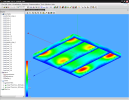 [+]
[+]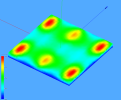 [+]
[+]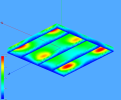 [+]
[+]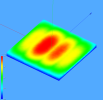 [+]
[+]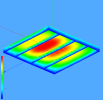 [+]
[+]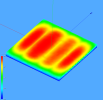 [+]
[+]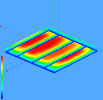 [+]
[+]